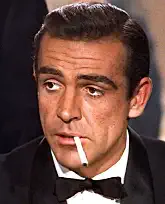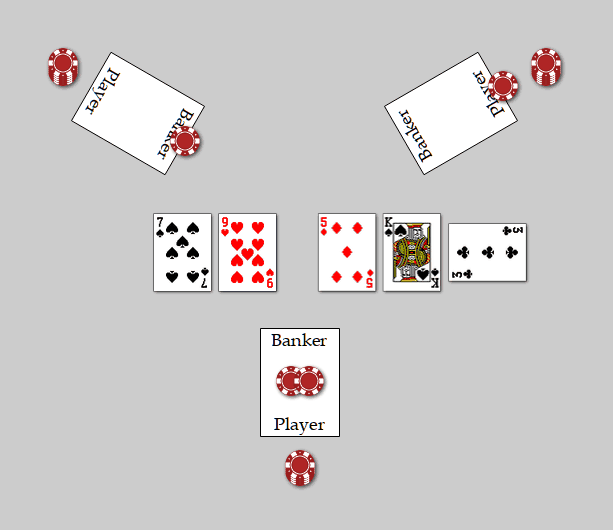
(The game was chemin de fer.)
Dining Room Baccarat

A baccarat game for recreational home play, where the players take turns being dealer, and imagine themselves saying, “Bond. James Bond.”
Punto banco, the baccarat played in casinos today, is a card game between two hands, designated Player and Banker (capitalized for clarity), on which bettors place wagers. Dining room baccarat is similar, but the deal rotates among the players, along the lines of chemin de fer; and each wager pays even money (with one exception), as in EZ Baccarat.
In baccarat, aces are worth one point, twos through nines are worth face value, and tens and face cards are worth zero.
When totaling the hand value, keep only the final digit. For example, 2 + 3 = 5, A + 8 = 9, 5 + Q = 5, 6 + 7 = 3.
Any number of decks may be used; two is convenient but one will do.
Each player starts with three chips × the number of other players (2 other players = 6 chips etc.), or more for a longer game.
Deal one card to each player to determine the first dealer. Keep dealing to tied players until someone wins. The other players are the bettors for the first round.
Shuffling: the dealer burns one card, then (optionally) burns a number of cards equal to the value of the first card (tens and face cards are worth 10 for this purpose). A cut card or joker is placed 7 cards from the end of the deck; when it appears, finish a round in progress then shuffle.
Play
The bettors wager one chip each, for either Player or Banker; the dealer matches with one chip for each of the bettors.
Bettors place their bets on a piece of paper, index card, napkin, or similar object; Player bets go on the near edge and Banker bets on the far edge. Put side bets on a side edge.
The dealer deals two cards each for Player and Banker, and then follows the usual rules:
1. If either Player or Banker has a score of 8 or 9 (a natural), the higher score wins.
2. Player stands to 6-7. Then:
Banker stands to 6-7.
Banker draws to 0-5. (same as Player)
| Banker’s hand |
Player’s third card | |||||||||||
| 0 | 1 | 2 | 3 | 4 | 5 | 6 | 7 | 8 | 9 | |||
| 0 - 2 | ||||||||||||
| 3 | ||||||||||||
| 4 | ||||||||||||
| 5 | draw | |||||||||||
| 6 | stand | |||||||||||
| 7 | ||||||||||||
3. Player draws to 0-5. Then:
| if Player’s third card is: | Banker draws to: (always to 0-2, never to 7) |
| 0-1 | 0-3 |
| 2-3 | 0-4 |
| 4-5 | 0-5 |
| 6-7 | 0-6 |
| 8 | 0-2 |
| 9 | 0-3 |
The higher score wins. The dealer pays one chip to each bettor whose wager won, and collects one chip from each whose wager lost.
Ties push (no one wins, dealer deals again).
If Banker wins with a three-card total of seven (a Dragon 7), Banker bets push (to replace the customary 5% house commission on Banker wins); Player bets still lose.
The deal passes counterclockwise to the next player who has enough chips to match all the other players’ wagers. That player may pass the deal, unless no one else wishes to be dealer.
Last player standing wins.
Additional bets
A bettor and the dealer may agree to wager more than one chip for Player or Banker; the dealer must be able to match the wager.
The following are side bets, and pay 2:1 - 4:1 as indicated. A bettor may ask to place one; the dealer must agree. (A bet must still be placed for Player or Banker.) Since higher payouts affect the dealer more, the dealer’s edge increases with increasing payout. The edge of the selected 2:1 bet is determined by the balance of bettor desperation and dealer avarice. (https://wizardofodds.com/games/baccarat/appendix/5/, https://wizardofodds.com/games/baccarat/side-bets/winning-total/)
| payout | dealer’s edge | probability | |
| Final 6: the final number of cards is 6 | 2:1 | 4.7% | 0.32 |
| Final 5: the final number of cards is 5 | 2:1 | 8.9% | 0.30 |
| Winning 8: the winning hand has a total of 8; tie pushes | 3:1 | 13% | 0.22 |
| Winning 7: the winning hand has a total of 7; tie pushes | 4:1 | 21% | 0.16 |
Side bets are made at the dealer’s discretion. Given their relatively low probabilities of winning, the dealer need not be able to match multiple side bets. (Bettors are to take this into consideration before placing one.) After paying all winning Player and Banker bets and collecting all losing bets, if unable to pay the outstanding side bets, the dealer is bankrupt. The dealer’s remaining chips are distributed among the side bettors. If they do not divide evenly, the odd chips are dealt to the side bettors clockwise.
Notes
The dealer has a slight advantage over Banker (1.02%) and Player (1.24%). (https://wizardofodds.com/games/baccarat/basics/, https://wizardofodds.com/games/ez-baccarat/)
The Banker bet thus has a very slight advantage over the Player bet.
Baccarat is usually thought of as a stately, aristocratic game, whose outcome is (mostly) pure chance. Besides the choice of betting Player or Banker, the bet increases and side bets above are ways to shake (not stir) it up.
The bets in dining room baccarat all have low (4:1 or less) payouts, since the players are playing against each other, not a casino with deep pockets. Casino baccarat includes a bet on Tie, for example; but it usually pays 8:1. And a bet on Dragon 7 pays 40:1.
The baccarat versions chemin de fer and baccarat banque allow Player and Banker to accept or refuse a third card under certain conditions. In reality, the punto banco rules above are the optimum strategy for both hands. (https://wizardofodds.com/games/chemin-de-fer/)
Example

Each player started with six chips.
Clockwise from bottom:
player 1 is the dealer and has set out one chip for each bettor;
player 2 bet on Banker;
player 3 bet on Player.
Player was dealt 7 + 9 = 6 and drew no cards.
Banker was dealt 5 + K = 5 and drew a 3 to win with 8.
The dealer will pay one chip to player 2 and collect one chip from player 3.
Two of the side bets above would have won. If a bettor had bet one chip on Final 5, for example, the dealer would pay two chips for that bet (2:1).
The deal now passes counterclockwise to player 3.
Please visit russellcottrell.com | blog